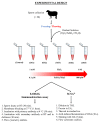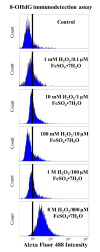Determination of Ram (Ovis aries) Sperm DNA Damage Due to Oxidative Stress: 8-OHdG Immunodetection Assay vs. SCSA®
- PMID: 36496807
- PMCID: PMC9737133
- DOI: 10.3390/ani12233286
Determination of Ram (Ovis aries) Sperm DNA Damage Due to Oxidative Stress: 8-OHdG Immunodetection Assay vs. SCSA®
Abstract
Conventional DNA analysis techniques can hardly detect DNA damage in ruminant spermatozoa due to high DNA compaction in these cells. Furthermore, these techniques cannot discriminate whether the damage is due to oxidative stress. The main purpose of this study was to evaluate the efficacy of two techniques for determining DNA damage in ovine sperm when the source of that damage is oxidative stress. Semen samples from twenty Manchega rams (Ovis aries) were collected and cryopreserved. After thawing, the samples were subjected to different levels of oxidative stress, and DNA oxidation was quantified using an 8-hydroxy-2′-deoxyguanosine (8-OHdG) immunodetection assay and Sperm Chromatin Structure Assay (SCSA®). For this purpose, we evaluated five different concentrations of an oxidation solution (H2O2/FeSO4•7H2O) on ram sperm DNA. Our study with the 8-OHdG immunodetection assay shows that there are higher values for DNA oxidation in samples that were subjected to the highest oxidative stress (8 M H2O2/800 µM FeSO4•7H2O) and those that were not exposed to high oxidative stress, but these differences were not significant (p ≥ 0.05). The two SCSA® parameters considered, DNA fragmentation index (DFI %) and high DNA stainability (HDS %), showed significant differences between samples that were subjected to high concentrations of the oxidation agent and those that were not (p < 0.05). We can conclude that the 8-OHdG immunodetection assay and SCSA® detect DNA damage caused by oxidative stress in ovine sperm under high oxidative conditions; SCSA® is a more straightforward method with more accurate results. For these reasons, an oxidative-stress-specific assay such as 8-OHdG immunodetection is not needed to measure DNA damage caused by oxidative stress in ram sperm samples.
Keywords: 8-OHdG; DNA; SCSA®; flow cytometry; oxidative stress; ram sperm.
Conflict of interest statement
The authors declare that they have no conflict of interest.
Figures






Similar articles
-
Ovine sperm DNA oxidation quantification using an 8-OHdG immunodetection assay.Reprod Domest Anim. 2019 Oct;54 Suppl 4:59-64. doi: 10.1111/rda.13533. Reprod Domest Anim. 2019. PMID: 31625228
-
Sperm chromatin structure assay (SCSA®).Methods Mol Biol. 2013;927:147-64. doi: 10.1007/978-1-62703-038-0_14. Methods Mol Biol. 2013. PMID: 22992911
-
Comparative evaluation of DNA integrity using sperm chromatin structure assay and Sperm-Ovis-Halomax during in vitro capacitation of cryopreserved ram spermatozoa.Reprod Domest Anim. 2019 Oct;54 Suppl 4:46-49. doi: 10.1111/rda.13519. Reprod Domest Anim. 2019. PMID: 31625230
-
Sperm chromatin structure assay parameters are not related to fertilization rates, embryo quality, and pregnancy rates in in vitro fertilization and intracytoplasmic sperm injection, but might be related to spontaneous abortion rates.Fertil Steril. 2008 Aug;90(2):352-9. doi: 10.1016/j.fertnstert.2007.06.018. Epub 2007 Sep 27. Fertil Steril. 2008. PMID: 17904130 Review.
-
Environmental toxicants cause sperm DNA fragmentation as detected by the Sperm Chromatin Structure Assay (SCSA).Toxicol Appl Pharmacol. 2005 Sep 1;207(2 Suppl):532-7. doi: 10.1016/j.taap.2005.03.021. Toxicol Appl Pharmacol. 2005. PMID: 15987647 Review.
Cited by
-
Minimizing sperm oxidative stress using nanotechnology for breeding programs in rams.J Anim Sci Biotechnol. 2023 Aug 10;14(1):106. doi: 10.1186/s40104-023-00907-3. J Anim Sci Biotechnol. 2023. PMID: 37559077 Free PMC article.
-
The characterization of CellROX™ probes could be a crucial factor in ram sperm quality assessment.Front Vet Sci. 2024 Feb 27;11:1342808. doi: 10.3389/fvets.2024.1342808. eCollection 2024. Front Vet Sci. 2024. PMID: 38476170 Free PMC article.
-
Association of sperm DNA fragmentation with higher miscarriage rates in non-male factor infertility reproductive cycles.Transl Androl Urol. 2025 May 30;14(5):1456-1465. doi: 10.21037/tau-2025-322. Epub 2025 May 27. Transl Androl Urol. 2025. PMID: 40529018 Free PMC article.
-
Application of Flow Cytometry Using Advanced Chromatin Analyses for Assessing Changes in Sperm Structure and DNA Integrity in a Porcine Model.Int J Mol Sci. 2024 Feb 6;25(4):1953. doi: 10.3390/ijms25041953. Int J Mol Sci. 2024. PMID: 38396632 Free PMC article.
-
Assessment of the Sperm DNA Oxidative Damage by Immunofluorescence and Flow Cytometry.Methods Mol Biol. 2025;2897:331-340. doi: 10.1007/978-1-0716-4406-5_23. Methods Mol Biol. 2025. PMID: 40202646
References
-
- Noblanc A., Damon-Soubeyrand C., Karrich B., Henry-Berger J., Cadet R., Saez F., Guiton R., Janny L., Pons-Rejraji H., Alvarez J.G., et al. DNA oxidative damage in mammalian spermatozoa: Where and why is the male nucleus affected? Free Radic. Biol. Med. 2013;65:719–723. doi: 10.1016/j.freeradbiomed.2013.07.044. - DOI - PubMed
Grants and funding
- AGL2017-85603-P/Ministerio de Ciencia e Innovación, Spain
- PID2020-120281RB-I00/Ministerio de Ciencia e Innovación, Spain
- SBPLY/17/180501/000369/Education and Science Council of Junta de Comunidades de Castilla-La Mancha, Spain
- SBPLY/21/180501/000111/Education and Science Council of Junta de Comunidades de Castilla-La Mancha, Spain
LinkOut - more resources
Full Text Sources

